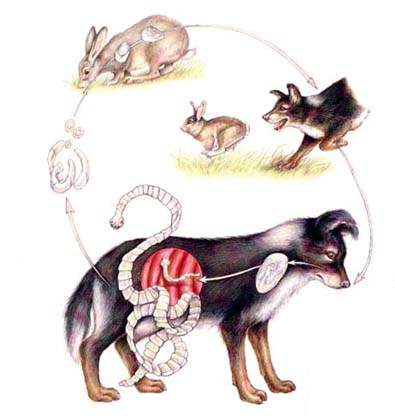Tapeworm Infection: Diagnosis, Treatment and Prevention
Tapeworms are common parasites that live in the small intestine of dogs, cats and other animals. Dipylidium caninum, the most common tapeworm of dogs and cats, is transmitted by fleas. Dogs and cats become infected with this tapeworm by ingesting fleas (during self grooming and licking). Two other types of tapeworm are also very common. Taenia pisiformis in the dog, and Taenia taeniaeformis in the cat are transmitted by rabbits and rodents (mice, rats squirrels). Dogs and cats become infected after ingesting one of these infected animals.


The Tapeworm
The adult tapeworm consists of a head and a very long body. The body is made up of many segments. Some of the segments (called proglottids) break off and are passed in the feces. The proglottids are cream colored and are often seen attached to fur around the animal's anus. The proglottids (segments) of Dipylidium caninum are very mobile and crawl around the animal's anal area. This produces an itching sensation and causes the animal to "scoot" across the floor.
Symptoms & Diagnosis
Tapeworms are diagnosed by identifying the proglottids (segments). These segments are about the size of a grain of rice and are found in the pet's bedding, attached to the fur around the anus, or in the feces.
Tapeworm infection rarely causes noticeable clinical symptoms. A voracious appetite is sometimes observed as well as a slight decline in body condition.
Treatment & Prevention
Medication is available for treating tapeworm infection. The medication kills the adult worm. After successful treatment, segments are no longer seen in the feces.
Flea prevention is an excellent method of controlling Dipylidium caninum infection. Taenia infections are controlled by reducing the pet's contact with intermediate hosts (rabbits and rodents).

